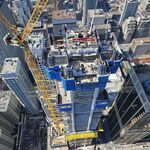BurlOak
Senior Member
Thanks,From photos I have seen, the road was open until there was room under the timber beam for equipment to dig the earth. Once that was done, then traffic and streetcar ran on top of it until it had to be back fill for the new road and sidewalks to be built.
The impression is given that Yonge was an open pit for 5 years.
I am still convinced that with precast concrete and high-early (HE) strength concrete (formerly Type 30), they could cut, lay down tunnel, and cover within a month. At the stations, they would have to do decking (similar to the photo above), but the excavation would be half the depth (or less) of the tunneled station and its construction would be done in less time than the current method. (Eglinton may be an exception, because if the road has steep grades, the cuts may become excessively deep).







